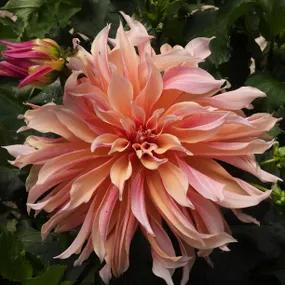Labyrinth Dahlia Tubers

The details
- Colour: pinky orange
- Flower size: 18cm
- Type: dinnerplate dahlia
- Cutting: yes
- Height/spread: 1m x 70cm
- Flowering: July to November
- Planting months: end Feb to July
Recommended extras
Description
Labyrinth: Decorative Dahlia Tubers
Labyrinth is a dahlia to lose yourself in: flamboyant and glamorous, the flowers, which easily reach 18cm in diameter, are big enough for some to call it a 'dinner plate'. They are awash with a shock of gently twisted linear petals in shades of sunset orange and rose pink.
Browse our other Decorative Dahlias or our full range of Dahlias.
The plant itself will grow to around 1m in height and is covered in fresh green foliage, with beautifully coloured, deep mahogany russet flower stems, which complements the flower colour wonderfully.
Like most dahlias, it is a good subject for cutting and bringing indoors to create vases of colour. The flowers last well and are really eye-catching.
Features
- Colour: pinky orange
- Flower size: up to 18cm
- Type: Decorative dahlia
- Cutting: Great
- Height/spread: 1m x 70cm
- Flowering: July to November
- Outdoor Planting Months: March to July
Growing Labyrinth Dahlias
All dahlias do best in deep rich soil with good drainage in a sunny spot. If it is windy they will need staking. They are greedy, thirsty plants so will need watering in dry spells, and they will always flower that little bit better if there is a bit of soluble food in the watering can once every couple of weeks.
The weight of the flower heads make this one for a sheltered place. It is generally more convenient to put support stakes in at planting time, rather than leaving it until there is foliage in the way.
Planting Companions for Labyrinth
A good partner for could be the deep claret Rocco, which is smaller and so could be planted at the front of the border. Its neat pompom shape and rich jewelled tones would set Labyrinth off wonderfully. Or combine with wafting grasses with good autumn colour, or tall airy Verbena bonariensis, or even a few purple penstemons to bring out the colour of Labyrinth's stems.
Did You Know?
This modern Dutch variety was released in 2013 by Koot.
Planting Instructions
If you ignore seed, Dahlias can be planted at three stages: as tubers, rooted cuttings and pot-grown plants.
Tubers can be planted at any time from March onwards. The hole should be at least double the diameter of the tuber laid out on the ground. Incorporate about 25% well rotted compost and if drainage is in any way doubtful then add plenty of horticultural grit as well. Plant one tuber per hole, leaving 60-80 cms between plants (depending on final size) and make sure the tuber is covered with 10-12 cms (4-5") of soil. This is important as it will insulate the tuber against frosts in March-May as they will take a couple of months to show.
Rooted cuttings, which are available from early April onwards, will need to be potted up and kept in a sunny and frost free place until they are ready to be planted out in mid May. Their treatment then is the same as for tubers except they are planted level with rather than 10 cms below the surrounding soil level.
Pot grown plants are not delivered until June, and are then planted out immediately in the same way as an established rooted cutting.
The more you deadhead, the more flowers you'll get.


